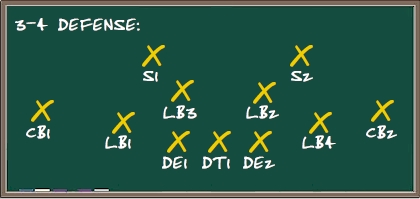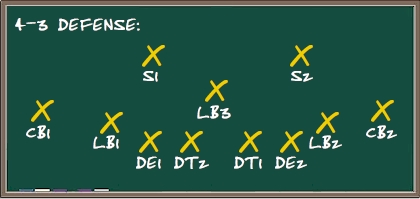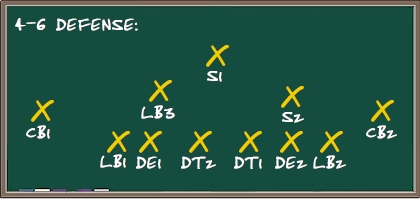|
The USAFL Defensive Play Set is comprised of 3 defensive schemes: 3-4, 4-3 and 4-6. Each scheme is described in detail below.

NICKEL: DE1, DE2, DT1, LB1, LB2, LB3, S1, S2, CB1, CB2, CB3
DIME: DE1, DE2, DT1, LB1, LB2, S1, S2, S3, CB1, CB2, CB3
DESCRIPTION: The 3-4 defensive scheme features 3 down linemen and 4 linebackers in base 1st and 2nd down packages. The defense tends to be oriented around strong coverage in pass defense and a stable run defense.
FORMATIONS:
Okie - Base 3-4
Under - DL shifted Strong Side
Over - DL shifted Weak Side
DL: Emphasis in 1nd and 2nd down using 3 DL and 4 LBs. I prefer ST
and AG in this set, because it is the responsibility of the DL to control
the line of scrimmage and let the LBs do their thing.
LB: Tendency is for LB1 to come off the blind side of the QB
rushing the passer (like a 4th DL) and LB4 to play strong side in run
support and against the TE when he releases as a receiver. LB2 and LB3,
although at times will rush the passer either together or in alternating
cycles, will tend to read the play, dropping in to middle zone coverage in
passing situations, and crashing/sliding along the line of scrimmage in
inside/outside running plays respectively. With a group of LBs with high
AC, should be able to put enough pressure on the QB to get good sack
numbers (i.e. the VIKINGS over the years)
DB: Play a higher mix of zone defense, which may prevent the big
running and passing plays, but will usually be less stout against the run
(unless you really have a dominant group of DL and LBs). You need DBs with
higher AC and IN for zone coverage because you need your DBs to pick up
the receiver who enters the zone quickly (which is part quickness and part
instinct and attention to details). Generally solid against the pass since
a higher number of defensive players are clogging up passing lanes.
NFL BASIS: 1990's Steelers, 1990's Bills
KEY STATISTICAL OUTCOMES:
YARDAGE (per game)
Rushing 108
Passing 210
Total 318
OTHER (per game)
Sacks 4.16
Interceptions 0.59
Points Allowed 16.2
Wins (per 14 game season) 7.2

NICKEL: DE1, DE2, DT1, DT2, LB1, LB2, S1, S2, CB1, CB2, CB3
DIME: DE1, DE2, DT1, DT2, LB1, S1, S2, S3, CB1, CB2, CB3
DESCRIPTION: The 4-3 defensive scheme features 4 down linemen and 3 linebackers in base 1st and 2nd down packages. The defense tends to be oriented around solid run defense and stable pass defense with consistent pressure on the pocket.
FORMATIONS:
Pro 4-3, Strong (SLB on LOS)
Pro 4-3, Weak (WLB on LOS)
Eagle 4-3 (all LBs off the LOS)
DL: 4 down lineman who for the most part attack the QB. Quicker
(SP), faster (SP) DL are preferred for my taste in this D. Because the DL
are more likely to get into the backfield the 4-3 tends to be better
against the run than the 3-4 (mostly due to the likelihood to stop the RB
for a loss and lower the yards per attempt as a result).
LB: The middle LB (LB3) reads the play and will slide along the
line of scrimmage to make stops, so he should be fast (SP) and intelligent
(IN) to avoid getting hung up in traffic). The LB1 and LB2 have a mix of
zone responsibility in the flat (short to middle depth near the
sidelines), middle short zone responsibility and pass rushing/run blitzing
responsibility. In my mind, this is what probably makes the 4-3 the most
balanced of defenses RUN vs. PASS -- it is not intrinsically dominant in
either, but deals with both fairly well, and depending upon your personnel
(better LBs and DBs it will do better defending the PASS, better DL it
will perform better against the RUN).
DB: DBs will play more M2M than the 3-4, so keep an eye on the
skill attributes for these guys (SP/AC/AG) but they will get some zone
help from the LBs, letting them get involved in the running game so ST
could be of benefit in this scheme.
NFL BASIS: 1970's Steelers, 2000's Buccaneers
KEY STATISTICAL OUTCOMES:
YARDAGE (per game)
Rushing 93
Passing 231
Total 324
OTHER (per game)
Sacks 4.30
Interceptions 0.46
Points Allowed 17.4
Wins (per 14 game season) 6.9

NICKEL: DE1, DE2, DT1, DT2, LB1, LB2, S1, S2, CB1, CB2, CB3
DIME: DE1, DE2, DT1, DT2, LB1, S1, S2, S3, CB1, CB2, CB3
DESCRIPTION: The 4-6 defensive scheme features 4 down linemen and 2 linebackers pressuring the line of scrimmage in base 1st and 2nd down packages. The defense is attack oriented often bringing 8 men in the "box" to defend the run and place extreme pressure on the QB. While pressure on the pocket is high, pass coverage can be exploited.
FORMATIONS:
"46" Defense
DL: Pretty similar line schemes for the 4-6 as are in place for the
4-3. The key difference in this scheme where the line of scrimmage is
concerned is with how the LBs are used.
LB: The LBs press the line of scrimmage, and tend to not be
involved in pass protection as much as the 4-3. A high AC/ST LB1 will play
very well in this scheme since he is essentially a 5th down lineman coming
in from the QBs blind side (see CHICAGO's future Hall of Famer Harris
Hayes). Because of the LB play, this defense is the best against the run
but will suffer a bit in the passing game.
DB: The highest mix of M2M coverage if I recall and the least
amount of support in the passing game by the LBs, so you better have an
extremely dominant group of DBs who have it all (SP, AC, AG, ST, IN) to
avoid losing a man in coverage, missing a tackle, or letting the WR
separate on cut routes, etc.
NFL BASIS: 1980's Bears, 1990's Eagles, 2000's Titans
KEY STATISTICAL OUTCOMES:
YARDAGE (per game)
Rushing 77
Passing 248
Total 325
OTHER (per game)
Sacks 4.28
Interceptions 0.55
Points Allowed 17.7
Wins (per 14 game season) 6.9
|